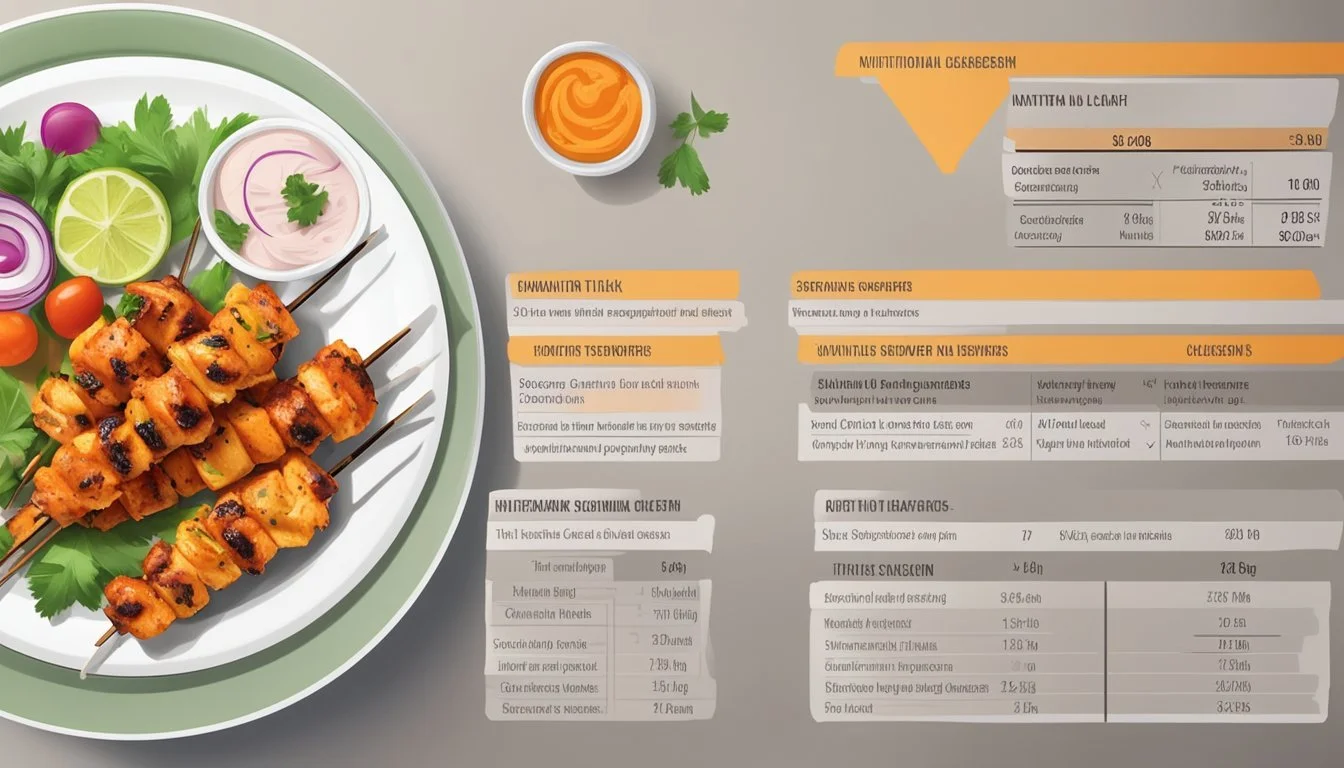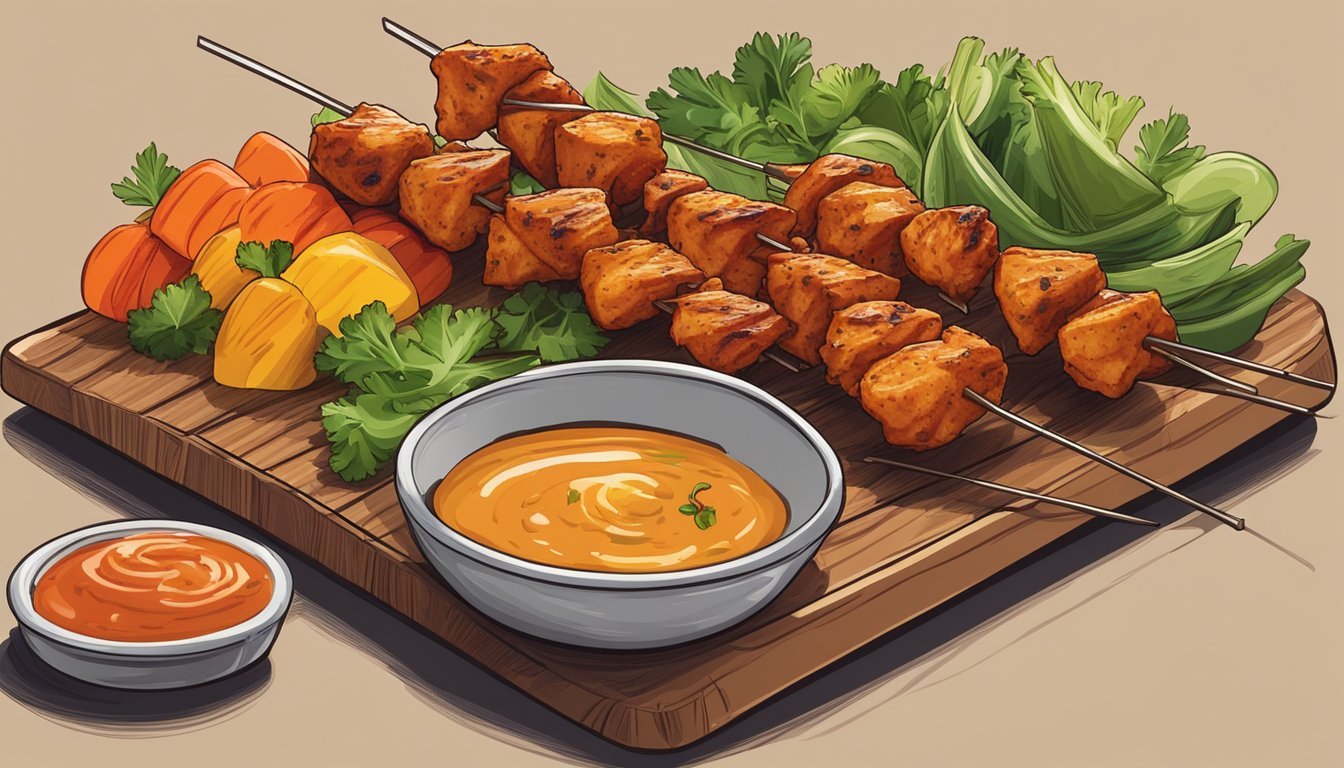How Long Do Chicken Tikka Skewers Last?
Expert Shelf Life Guide
Chicken tikka skewers are a flavorful and versatile dish that can be enjoyed fresh or stored for later use. Properly stored in the refrigerator, chicken tikka skewers can last for up to 3-4 days. This makes them a convenient option for meal prepping or enjoying leftovers throughout the week.
When considering storage, it's essential to ensure that chicken tikka skewers are placed in an airtight container to maintain their flavor and prevent contamination. Freezing is another option, which can extend the shelf life to about 2-3 months if stored correctly.
Understanding the storage methods and duration can help prevent food waste while ensuring you always have a delicious meal ready. Cooking methods like grilling, baking, and air frying each have unique impacts on the dish's longevity and taste when stored.
Overview of Chicken Tikka Skewers
Chicken tikka skewers are a popular dish made with marinated chicken threaded onto skewers and cooked to perfection. Key points to consider are the definition of chicken tikka skewers and the primary ingredients used in their preparation.
What Are Chicken Tikka Skewers?
Chicken tikka skewers consist of bite-sized chicken pieces marinated in a blend of spices and yogurt before being grilled or baked. Originating from Indian cuisine, these skewers enjoy great popularity worldwide.
Traditionally, they are made by skewering the marinated chicken onto sticks and cooking them over high heat. This results in juicy, flavorful pieces with a slightly charred exterior. Commonly served with fresh vegetables or rice, chicken tikka skewers can also be accompanied by a cooling yogurt dip.
Key Ingredients in Chicken Tikka
Key ingredients include chicken, yogurt, lemon juice, garlic, and a variety of spices. Boneless chicken is typically used, often breast or thigh pieces for their tenderness.
The marinade is the heart of this dish, usually composed of yogurt and lemon juice to tenderize the meat. Garlic adds depth, while a mix of spices such as garam masala, cumin, coriander, turmeric, salt, and pepper provide robust flavor. Sometimes, chilli is added for extra heat.
Blending these ingredients thoroughly ensures the flavors penetrate the chicken deeply, resulting in a delicious, aromatic skewer. The use of fresh vegetables like cucumber and red onion often complements the final dish, adding a refreshing contrast.
Preparation Methods
To maximize the flavor and texture of chicken tikka skewers, it's crucial to focus on marinating properly, using appropriate skewering techniques, and cooking with the right methods.
Marinating the Chicken
Marinating chicken tikka often starts with a yogurt-based marinade. Yogurt helps to tenderize the meat while adding a rich flavor. Combine yogurt with garlic, lemon juice, and a blend of spices like turmeric, garam masala, and chili powder.
Spices can be adjusted based on personal preference for heat and flavor. Ginger-garlic paste is a common addition to this mix. The chicken should be cut into bite-sized pieces to ensure an even marinade. Let it rest covered in the refrigerator for 3 to 4 hours, or ideally overnight, to enhance the depth of flavor.
Skewering Techniques
Using proper skewers is key for even cooking. Wooden skewers or bamboo skewers should be soaked in water for at least 30 minutes to prevent burning. Metal skewers can be used without soaking.
When skewering, alternate chicken pieces with vegetables like peppers, onions, or zucchini. This not only adds variety but also infuses additional flavors. Ensure that pieces are spaced evenly to allow heat to circulate and cook the meat thoroughly. Overcrowding the skewers can result in uneven cooking.
Cooking Chicken Tikka Skewers
Chicken tikka skewers can be cooked using various methods. For grilling, preheat the grill to medium-high and cook for about 6-8 minutes per side. If using an oven, set it to 425°F. Place the skewers on a lined baking sheet and cook for 20-25 minutes, turning halfway through.
Air fryers are also an effective method. Preheat to 400℉, place the skewers in a single layer, and cook for 8-10 minutes on each side. For added flavor, brush the chicken with butter or leftover marinade during the last few minutes of cooking. This gives a slight char and locks in moisture, enhancing the overall taste.
Storing Chicken Tikka Skewers
Proper storage of chicken tikka skewers ensures they remain fresh and delicious for future meals. This includes correct refrigeration techniques and effective freezing and thawing methods.
Refrigeration Best Practices
Chicken tikka skewers should be placed in an airtight container before storing in the refrigerator. This helps maintain their moisture and prevents them from absorbing other flavors. They can safely last in the fridge for 3-4 days.
It's essential to refrigerate them within two hours of cooking to reduce the risk of bacterial growth. When reheating, ensure the internal temperature reaches at least 165°F (74°C). Use a food thermometer for accuracy.
If you plan for meal prep, label containers with the date they were stored to keep track of freshness. Avoid overcrowding the fridge, as consistent airflow around the containers helps maintain an even temperature.
Freezing and Thawing
To extend the shelf life of chicken tikka skewers, freezing is a great option. Wrap each skewer tightly in aluminum foil or plastic wrap before placing them in a freezer-safe container or bag. Frozen chicken tikka skewers can last up to 2-3 months.
When ready to use, thaw them in the refrigerator overnight. This slow thawing process helps retain moisture and reduces the risk of contamination. Avoid thawing at room temperature as this can promote bacterial growth.
If reheating from frozen, use an oven preheated to 375°F (190°C) until they are heated through. Ensure they reach an internal temperature of at least 165°F (74°C) before consuming. Use the thawed skewers quickly to maintain quality and safety.
Nutritional Information
Chicken tikka skewers are not only delicious but also pack a punch in terms of nutrition. This section delves into their caloric content and protein contribution, crucial for anyone monitoring their dietary intake.
Caloric Content
Chicken tikka skewers provide a balanced intake of calories, primarily from lean chicken breast or thighs. Each skewer averages 150-200 calories, depending on the specific ingredients and portion size.
Marinades made with Greek yogurt and spices add minimal calories but enhance flavor significantly. Incorporating vegetables like red onion and yellow pepper can add nutrients without a substantial increase in calorie count. For those looking to manage their caloric intake, these skewers offer a flavorful yet light option.
Protein Contribution
Chicken tikka skewers are an excellent source of protein. On average, each skewer can contain 20-25 grams of protein, which is essential for muscle repair and growth.
Using lean chicken breast boosts the protein content while keeping fat levels low. When made with chicken thighs, the skewers offer a slightly higher fat content but still provide robust protein levels. The yogurt marinade also contributes to the overall protein content, making these skewers a power-packed option for those needing a protein boost.
Incorporating these skewers into your diet ensures you receive high-quality protein, aiding in maintaining a healthy, balanced diet.
Serving Suggestions
Serving chicken tikka skewers can be an exciting culinary experience with the right accompaniments and sauces. Enhancing the flavor and presentation can elevate the dish to new heights.
Accompaniments and Side Dishes
Chicken tikka skewers pair well with a variety of side dishes. Basmati rice or a fragrant pilaf makes an excellent foundation, absorbing the luscious flavors. Naan bread is another popular choice, providing a soft, warm contrast to the grilled chicken.
Salads featuring fresh greens, cucumbers, and tomatoes bring a refreshing balance to the meal. Roasted vegetables, like bell peppers and onions, also complement the smoky taste of the tikka. Aloo Gobi, a spiced cauliflower and potato dish, offers a hearty vegetarian option.
Tables of side dish options can further assist in planning:
Side Dish Description Basmati Rice Aromatic rice that pairs well with chicken tikka Naan Bread Soft, warm bread perfect for scooping and dipping Fresh Salad Crisp greens with cucumber, tomato, and lemon juice Roasted Vegetables Bell peppers, onions, and other grilled veggies Aloo Gobi Spiced cauliflower and potato dish
Sauces and Condiments
The right sauces can enhance the flavors of chicken tikka skewers dramatically. Mint chutney offers a cool and refreshing flavor, blending mint, cilantro, and yogurt. Raita, another yogurt-based sauce, often includes cucumber and mint, adding a subtle, cooling contrast to the spicy chicken.
Serve tamarind chutney for a tangy, sweet dip that pairs excellently with the smokiness of the grilled chicken. Lemon wedges are also a must, adding a zesty kick when squeezed over the skewers. A drizzle of spicy achar (pickle) can introduce a pungent, fiery element.
Tables and lists can aid in understanding the condiment options:
Sauce/Condiment Flavor Profile Mint Chutney Cool, refreshing with mint and cilantro Raita Yogurt-based with cucumber and mint Tamarind Chutney Tangy and sweet Lemon Wedges Zesty and vibrant Spicy Achar Pungent, fiery pickle
These accompaniments and sauces not only complement the skewers but also enhance the dining experience, providing a variety of textures and flavors.
Cooking Variations and Alternatives
Chicken tikka skewers offer versatility in both spice levels and ingredient substitutions. Whether aiming for a mild or a fiery flavor, adjustments can cater to varied preferences while maintaining a delicious and authentic taste.
Spice Level Adjustments
Adjusting the spice level of chicken tikka skewers allows for personalized heat preferences. Using ingredients such as garlic paste, garlic powder, onion powder, and sea salt forms the base flavor.
For a milder dish, reduce or omit the chili powder, cayenne pepper, and paprika. Instead, focus on cumin, coriander, and turmeric for aroma and depth without overwhelming heat. Greek yogurt or natural yoghurt can also temper the spiciness while adding creaminess.
For a spicier dish, increase the amount of chili powder, cayenne, or hot paprika. Introducing garam masala and a splash of red onion can intensify the complexity and heat.
Substituting Ingredients
Substituting ingredients in chicken tikka skewers provides flexibility for dietary restrictions or ingredient availabilities. Greek yogurt can be swapped with natural yoghurt or a non-dairy alternative for those avoiding dairy, maintaining tenderness and tanginess.
Olive oil can take the place of more traditional oils and serve as a marinade base instead of yogurt for a different texture.
For a variation in flavor, replace coriander with ground coriander or fresh cilantro. Ground turmeric can substitute for fresh if not available. Using diced, marinated red onion adds a crunchy texture.
Garlic paste offers a smooth consistency, whereas garlic powder provides a more concentrated flavor, giving multiple flavor profiles for customization.
Experimenting with these modifications can lead to unique yet equally delicious variations of chicken tikka skewers.
Safety and Food Handling
Proper food safety and handling of chicken tikka skewers are essential to prevent foodborne illnesses and ensure that the chicken remains fresh for consumption. Critical practices include avoiding cross-contamination and properly storing chicken in the refrigerator.
Avoiding Cross-Contamination
Cross-contamination can occur when raw chicken comes into contact with other foods, utensils, or surfaces.
To prevent this, use separate cutting boards for raw chicken and other ingredients.
Wash hands thoroughly with soap after handling raw chicken and before touching anything else.
Sanitize all surfaces and utensils that have come into contact with raw chicken, using hot water and an appropriate cleaner.
Storage of marinade and chicken: If using a marinade, always marinate chicken in the refrigerator, not on the counter.
Use airtight containers to prevent any leakage.
If you plan to use some marinade as a sauce, set aside a portion before it touches the raw chicken to avoid contamination.
Properly implement these safety measures to maintain the quality and safety of your chicken tikka skewers.
Recipe Notes and Tips
These notes and tips focus on optimal marinade timing, selecting appropriate skewers, and determining the correct storage duration for chicken tikka skewers. Each aspect ensures your dish is perfectly flavored, safely prepared, and delicious over time.
Marinade Timing
Marinating chicken ensures that the meat absorbs flavors deeply. Yogurt, a typical component in the marinade, helps tenderize the chicken. Allowing the chicken to marinate for at least one hour at room temperature is key. For more intense flavors, overnight marination in the refrigerator is recommended.
Using lemon juice in the marinade adds a tangy zest and assists in tenderizing. Remove the chicken from the refrigerator at least 30 minutes prior to cooking. This ensures even cooking when the meat is at room temperature.
Skewer Selection
Choosing the right skewers affects the cooking process and presentation. Wooden skewers, like bamboo, need soaking in water for at least 30 minutes to prevent burning during grilling. Metal skewers, on the other hand, do not need soaking and offer the added benefit of even heat distribution.
When preparing chicken tikka kebabs, ensure the pieces are uniformly cut to cook evenly. Thread the chicken pieces close together but not too tightly, allowing for even grilling or air frying.
Storage Duration
Proper storage extends the lifespan of chicken tikka skewers. Once cooked, they can be stored in an airtight container in the refrigerator for up to 3 days. To maintain freshness, ensure they are cooled to room temperature before refrigeration.
For meal prepping or saving leftovers, chicken tikka skewers can be frozen. Pack them in a freezer-safe container or bag, where they can last for up to 2 months. Before reheating, defrost them in the refrigerator overnight to ensure they heat evenly.









